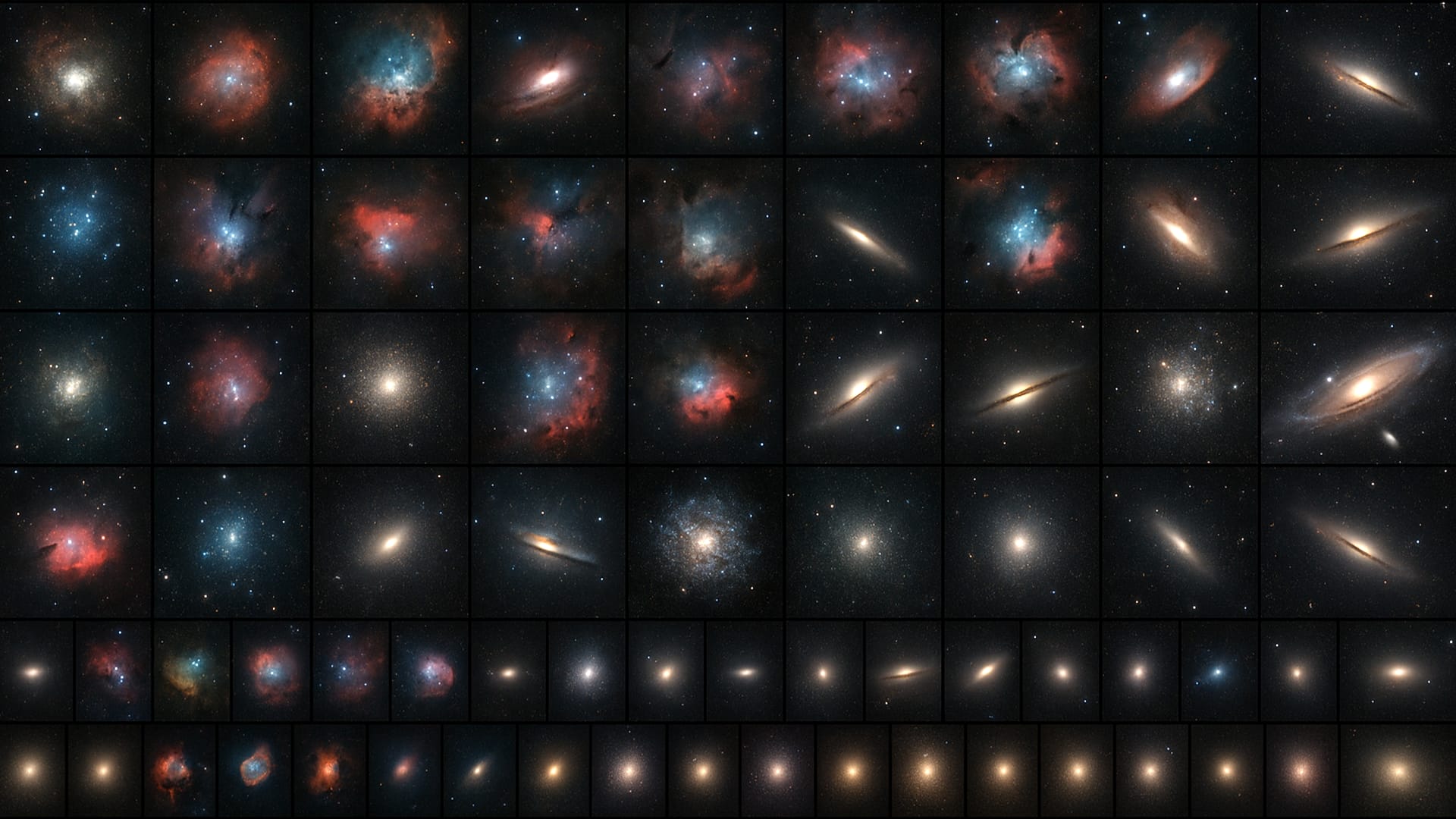Evolution of Astronomical Catalogs: From Ancient Lists to Billion-Star Databases
Humanity learned to map the sky step-by-step, from the constellations visible to the naked eye to objects hidden in the depths of space. Today, we use a variety of astronomical catalogs to navigate among the stars. In this article, we’ll look at what these catalogs are, why there are so many of them, and how they can be useful to an ordinary observer. To find the objects from the catalogs in the sky above you, use the free Sky Tonight app – type the object's catalog designation, and the app will show where to look.
Contents
- What is an astronomical catalog?
- The first star lists
- Basic deep-sky catalogs: M, C, NGC, IC
- Advanced astronomical catalogs
- SIMBAD: “one list to rule them all”
- Practical tips: how to use astronomical catalogs
- F.A.Q.
- Astronomical catalogs: a quick recap
What is an astronomical catalog?
An astronomical catalog is a curated list of celestial objects with names, coordinates, and basic data such as brightness, type, location etc.
Unlike an atlas, which is a visual map showing where objects appear in the sky, a catalog serves as a reference database, used to identify, measure, and compare them. Every observatory, telescope, and space mission relies on catalogs for accurate pointing, tracking, and calibration.
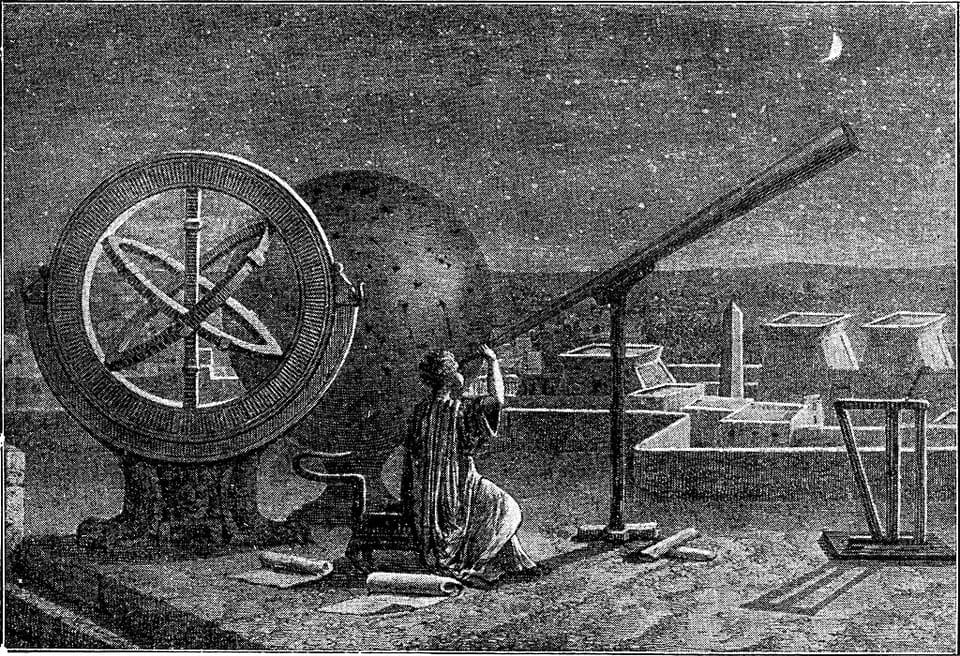
The first star lists
Long before modern telescopes, observers grouped stars into patterns and wrote them down.
- Hipparchus (2nd century BCE) compiled the first known quantitative list and introduced stellar magnitudes (1st to 6th).
- Ptolemy (2nd century CE) published the Almagest with about 1,020 stars (sources differ slightly), anchoring Western astronomy for centuries.
- In the Islamic Golden Age, al-Sufi (10th century) refined positions and brightness in The Book of Fixed Stars, adding drawings and corrections.
These catalogs focused on naked-eye stars, not on faint “fuzzy” objects that would later define deep-sky observing.
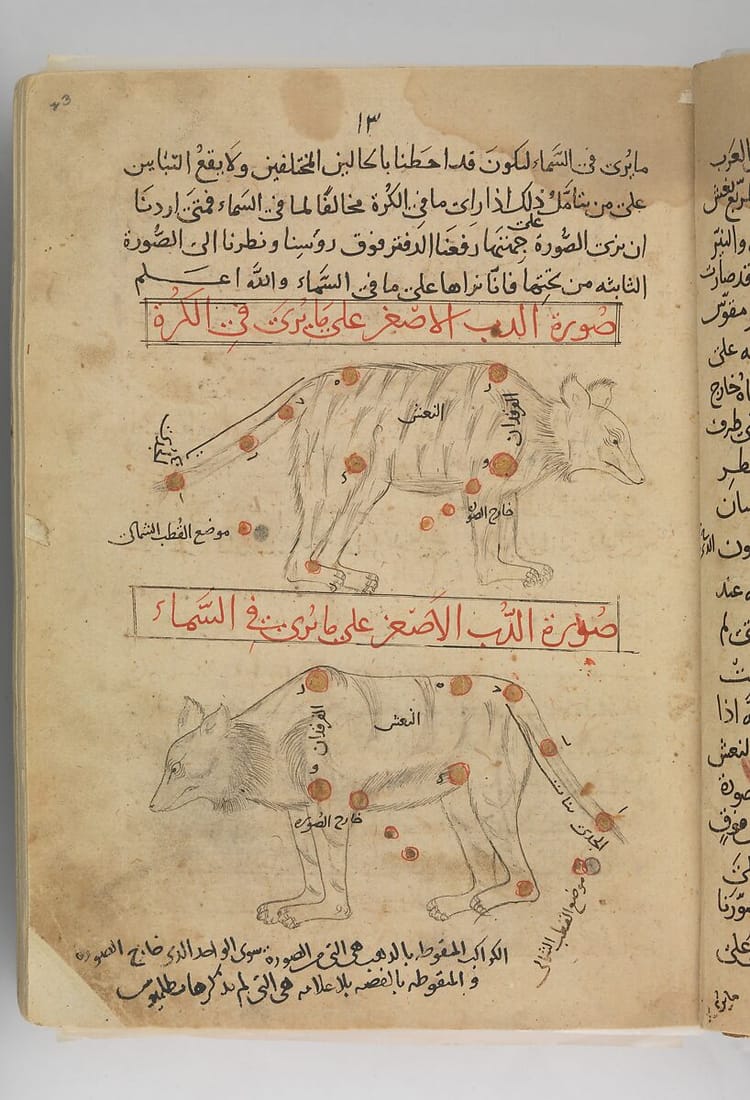
Basic deep-sky catalogs: M, C, NGC, IC
With the invention of telescopes, astronomers saw thousands of hidden lights invisible to the naked eye. Each new discovery demanded its place in the records — and so began the age of modern astronomical catalogs.
Messier and Caldwell: catalogs of brightest deep-sky objects
In the 18th century, French astronomer Charles Messier hunted comets. Through small telescopes, he kept spotting faint, motionless smudges. Comets usually move, but these smudges did not. To avoid false alarms, he began listing the confusing objects, making a practical “do-not-chase” list for comet hunters. The first edition (1774) included 45 objects. Within six years the list had doubled in size, and by 1781 it already contained 103 objects. The modern list, that is used by modern stargazers and is known as the Messier catalog, totals 110 objects.
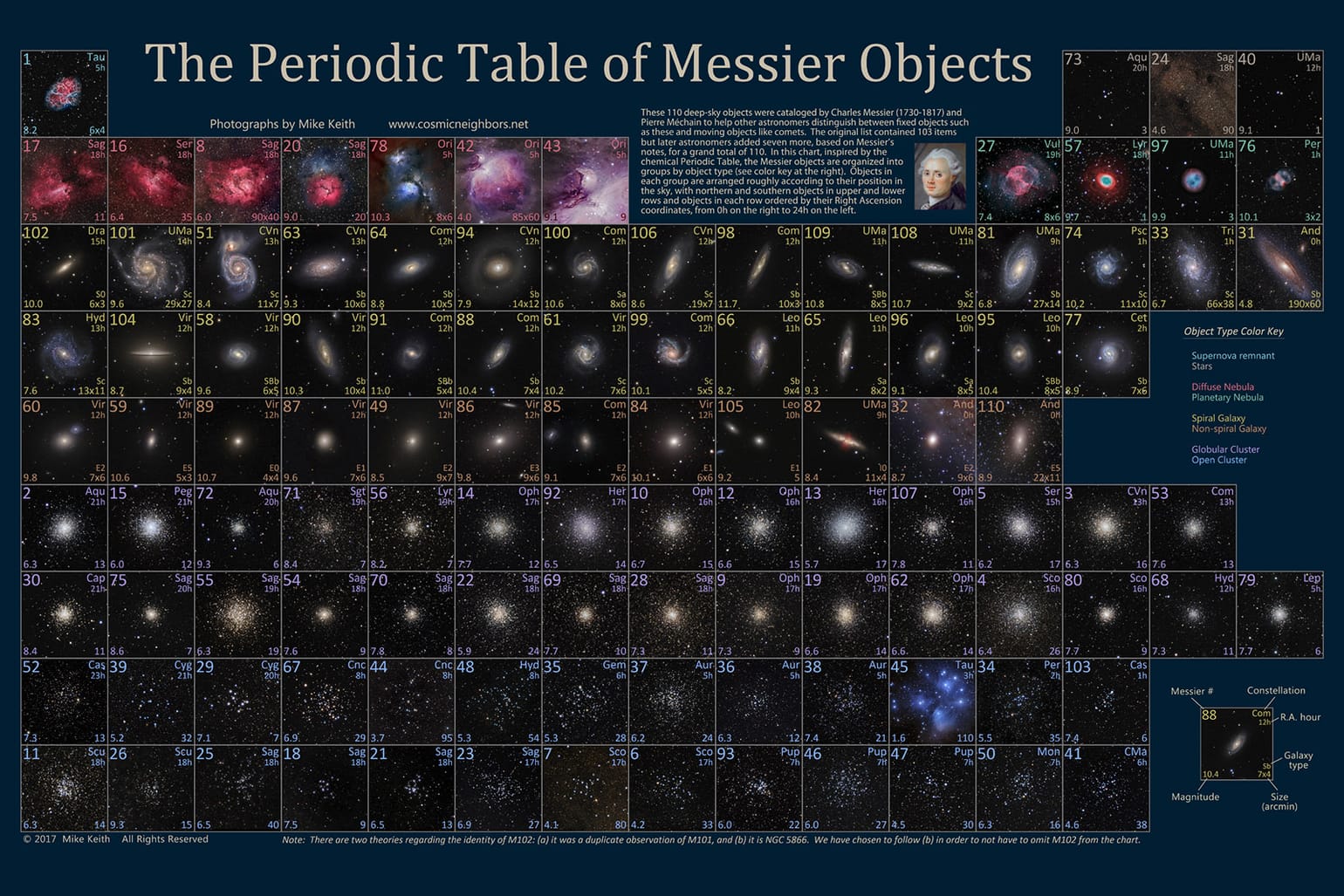
Messier’s entries include:
- Galaxies (e.g., M31 – Andromeda Galaxy)
- Globular clusters (e.g., M13 in Hercules)
- Open clusters (e.g., M45 – the Pleiades)
- Emission nebulae (e.g., M42 – the Orion Nebula)
- Planetary nebulae (e.g., M57 – the Ring Nebula)
The Messier list is a beginner’s roadmap to the brightest deep-sky targets of the northern sky. Many observers try the annual Messier Marathon, aiming to see as many M-objects as possible in one night. It takes place annually in March or April and is so popular that we wrote a guide on how to ace the Messier Marathon: where to start, how to finish, and what to bring.
If you carefully study the Messier Catalog, you will notice that it favors the Northern Hemisphere. Messier observed from Paris, so he could only see stars and nebulae that rose high enough above his horizon, roughly those north of 35° south latitude. That’s why spectacular sights of the southern sky, like the Magellanic Clouds or Omega Centauri, never made it into his list.
In 1995, British astronomer Patrick Moore proposed a catalog designed as a modern companion to the Messier list, highlighting bright deep-sky objects that Messier missed — especially those in the southern sky. He wanted its naming to follow the same logic as the Messier Catalog (M) — using the first letter of the author’s name. But since “M” was already taken by Messier, he chose “C” — from Caldwell, his mother’s maiden name. That’s how the Caldwell Catalog was born, with objects labeled C1, C106, and so on.
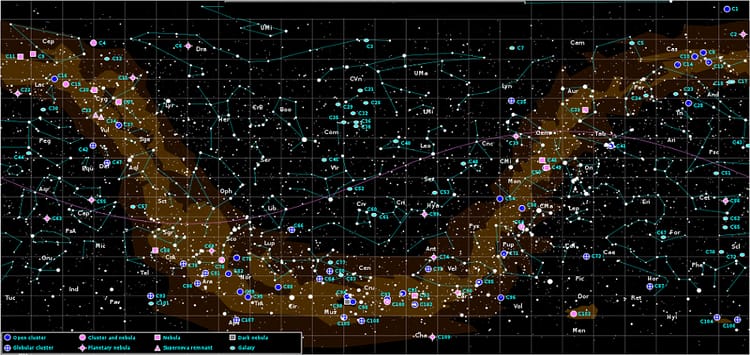
Patrick Moore ordered the objects by declination — that is, by how far north or south they appear in the sky. So the numbering runs north to south, not by discovery or brightness. Moore’s idea was to make it easier for observers in different hemispheres to plan what’s visible from their latitude.
Catalogs for skilled observers and astrophotographers: NGC and IC
As telescopes improved, observers discovered thousands of nebulae and clusters that were invisible to the naked eye. The New General catalog (NGC), published in 1888 by Danish–Irish astronomer J.L.E. Dreyer, was based largely on the systematic surveys of William and John Herschel, who had spent decades scanning the sky with large reflectors. The catalog listed 7,840 objects, describing their appearance and approximate positions. It was later expanded by two Index catalogs (IC, 1895–1908), bringing the total to over 13,000 entries. These catalogs became the backbone of professional and amateur astronomy: even today, many galaxies, clusters, and nebulae are primarily known by their NGC numbers.
Advanced astronomical catalogs
With each leap in technology, astronomers saw deeper into the cosmos — capturing stars and other space objects that earlier telescopes could not reveal.
Inspired by the photographic revolution: HD, BD, BSC
By the late 19th century, astronomy entered the photographic era. Glass plates made it possible to capture wide areas of the sky with unprecedented precision — the same exposure could reveal thousands of stars invisible to the eye.
- The pioneering project of that time was the Bonner Durchmusterung (BD), completed in Bonn, Germany. It cataloged about 324,000 stars down to magnitude 9-10. Later extensions such as the Córdoba Durchmusterung in Argentina and the Cape Photographic Durchmusterung in South Africa expanded coverage to the Southern Hemisphere, bringing the total to about 1.5 million stars and ensuring the entire sky was finally mapped. These surveys transformed star catalogs from thousands to millions of entries, laying the groundwork for all modern stellar databases.
In the early 20th century, attention shifted from positions to physical properties. Astronomers began recording not just where a star was, but what kind it was — its color, temperature, and spectrum.
- The Henry Draper catalog (HD), completed at Harvard College Observatory, assigned spectral types to 225,300 stars, defining the stellar classification system (O–B–A–F–G–K–M) still in use today.
- For brighter nearby stars, the Bright Star catalog (BSC) provided detailed data on positions, magnitudes, and spectral types, a concise reference still used today.
This photographic revolution changed not only how astronomers worked, but also how we see the Universe. To visualize this transformation – from the first telescope images to today’s space-based photography – check out our infographic.
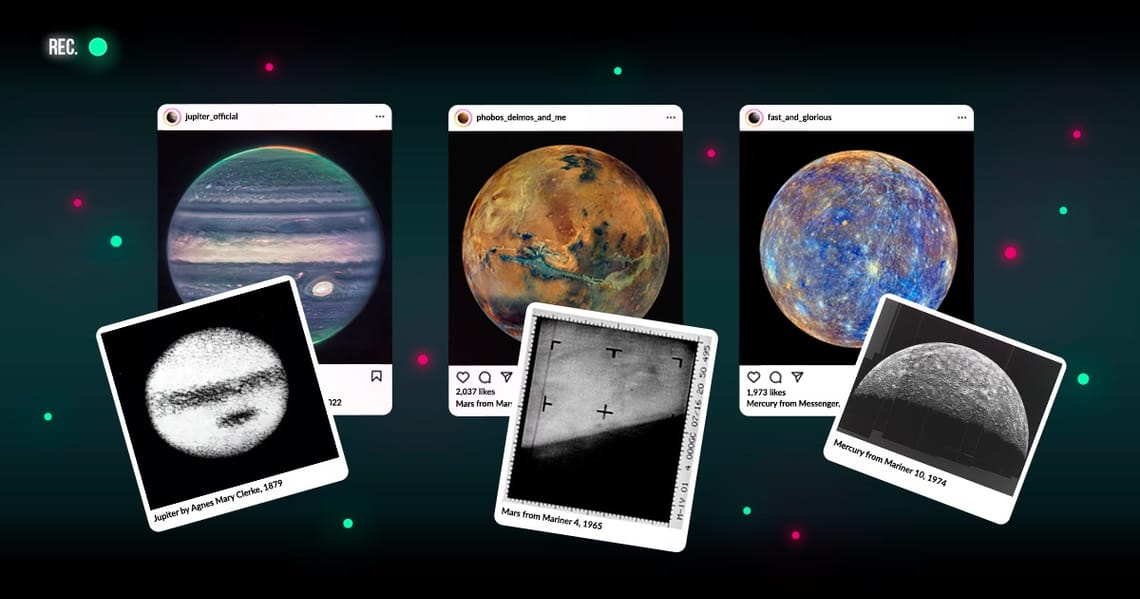
Space astrometry: HIP, TYC, Gaia
As technology moved beyond photographic plates, astronomers turned to space itself for greater precision. Ground-based observations were limited by Earth’s atmosphere, which blurred and distorted stellar positions. To overcome this, the European Space Agency launched missions dedicated to astrometry — the precise measurement of star positions and motions.
- Hipparcos satellite (operational 1989–1993) was the first space mission for astrometry, measuring accurate positions and distances for about 118,000 stars. Stars from this catalogue are labeled with the prefix HIP (for example, HIP 70890 — Alpha Centauri A).
- The related Tycho catalogs (published in 1997 and 2000) were derived from Hipparcos’ secondary data stream, extending the survey to about 2.5 million stars. Their entries are marked as TYC, such as TYC 7380-653-1.
- The ongoing Gaia mission, launched in 2013, continues this work on an unprecedented scale, mapping the Milky Way in 3D. It now includes about 1.8 billion stars, recording their positions, brightness, motions, and physical properties.
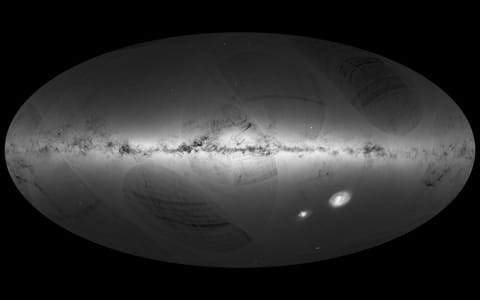
SIMBAD: “one list to rule them all”
As catalogs multiplied, the same celestial object often appeared under different names — for example, the Barnard’s Galaxy is listed as NGC 6822, IC 4895, and Caldwell 57. To keep these aliases connected, astronomers use the SIMBAD database (Set of Identifications, Measurements, and Bibliography for Astronomical Data), maintained by the Centre de Données astronomiques de Strasbourg (CDS).
SIMBAD acts as a universal index that cross-references objects across dozens of catalogs — from classical ones like Messier, NGC, and IC to modern survey names (2MASS, SDSS, Gaia). Each entry gathers:
- All known identifiers (names across catalogs);
- Coordinates and physical data;
- Bibliographic references to scientific papers.
If you encounter several names for what seems like the same object, SIMBAD confirms whether they’re indeed the same target and shows how it appears across catalogs and missions, essentially, a “who’s who” of the sky.
Practical tips: how to use astronomical catalogs
Astronomical catalogs aren’t just for professionals — they can be your personal sky checklist, guiding your observing sessions and helping you identify what you’re seeing. Here’s how to make them work for you:
- Start with objects from the Messier catalog if you’re new. They’re bright, easy to find, and look great in photos.
- Add Caldwell to reach southern or off-Messier highlights.
- Use NGC/IC catalogs when you’re ready to observe fainter, more challenging deep-sky objects that require darker skies or more advanced gear.
- If you’re interested in stars themselves, their types or properties, check the HD and BSC for spectral classifications and key data.
- To study stars’ positions and distances, refer to Gaia.
- Need to identify or cross-check an object across catalogs? Use SIMBAD — it links all major catalogs and helps you find every name an object goes by.
Once you know which catalog object you want to see, one of the easiest ways to find it is with astronomical apps.
- Star Walk 2 is perfect for visual exploration — it features the main catalogues you’ve read about here, including Messier, NGC, HIP, HR, and HD.
- If you want to go deeper, Sky Tonight provides a more advanced observing experience, combining Messier, Caldwell, NGC/IC, HIP, HD, and Tycho-2 with dozens of additional catalogues for nebulae, clusters, and galaxies.
You can use either Star Walk 2 or Sky Tonight to locate catalog objects in the real sky — just type the object’s name or ID (for example M42, NGC 869, or C106), and the app will show where and when to look.
F.A.Q.
Are astronomical catalogs good only for professional astronomers?
Not at all! Some catalogs, like Messier and Caldwell, were created specifically for visual observing — they highlight bright, easy-to-find objects that look great even through small telescopes or binoculars. They’re perfect starting points for beginners. Professional catalogs such as NGC, HD, or Gaia go deeper, offering detailed data used in research.
What’s the difference between Messier and NGC?
Messier includes 110 classic bright showpieces of the northern sky. NGC/IC lists tens of thousands of objects across the whole sky, widely used in research and advanced amateur work.
How do I know which star catalog to use?
If you’re observing visually, start with Messier or Caldwell — they highlight the brightest and most famous deep-sky objects. For fainter galaxies and nebulae, turn to the NGC/IC catalogs. To learn about individual stars, use HD or BSC for spectral types and properties. For precise distances and motions, rely on Gaia or Hipparcos. And if you need to match names across catalogs, SIMBAD is your universal reference.
How do I know which objects are visible from my latitude?
Each star catalog covers a different part of the sky. For example, the Messier list was created in Paris and includes mostly northern objects, while the Caldwell catalog adds many southern highlights. catalogs like NGC/IC, HD, or Gaia span the entire sky, but what you can see depends on your latitude — some objects never rise above your local horizon. To check which targets from any catalog are visible tonight, open the Sky Tonight app. It automatically filters the sky for your exact location and time, showing which Messier, Caldwell, or NGC objects are above the horizon right now.
Astronomical catalogs: a quick recap
Astronomical catalogs are maps and records of the night sky — from ancient naked-eye lists to modern billion-star databases. Today, this legacy lives in many forms: Messier and Caldwell guide the eye to bright showpieces; NGC/IC chart the deeper realms of galaxies and nebulae; astrometry missions like Gaia measure star positions and motions in exquisite detail; and SIMBAD unites them all, linking every name and dataset into one cosmic index. With Sky Tonight, you can explore the objects from these catalogs in your own sky — centuries of astronomy, right at your fingertips.
Clear skies and happy catalog hopping!
